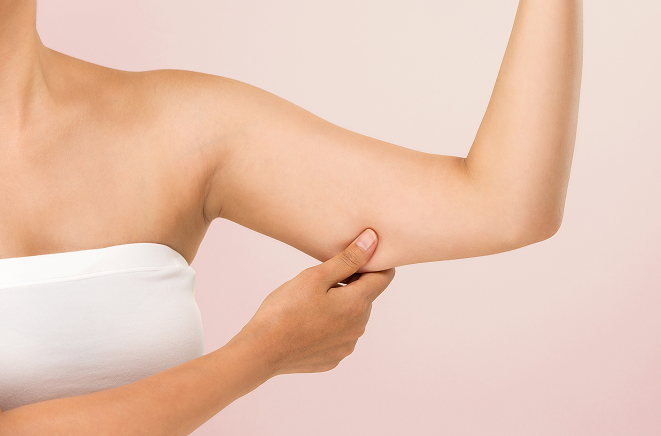Arm Lift
- Approximate duration: 2 to 3 hours
- Anesthesia: General
- Recovery: 4 weeks

Who is this procedure for?
Brachioplasty, also known as an arm lift or arm contouring, is intended for individuals with significant skin laxity on the inner part of the upper arms, often following major weight loss or as a result of aging. This procedure is particularly suitable for patients whose skin remains loose and sagging despite healthy eating habits and regular physical activity.
It is also appropriate for those who have stabilized their weight after substantial weight loss but whose skin has not regained its firmness. However, in patients whose skin is still firm but who present with localized fat deposits, liposuction alone may be sufficient to improve the contour without requiring a larger incision.
Ideal candidates for brachioplasty are in good general health, do not have medical conditions that could impair healing, and have realistic expectations regarding results and scarring. While most arm lifts produce a scar from the armpit to elbow on the inner aspect of the arm, a small percentage of patients can have an arm lift with scars limited only to the armpit. Dr. Nicolaidis will clarify the important differences between these approaches.
Who is brachioplasty not recommended for?
Brachioplasty is not recommended for individuals who have undergone a mastectomy with lymph node dissection. In such cases, patients are at risk of developing permanent swelling in the arms.
Are the results of this procedure permanent?
The results of an arm lift (brachioplasty) can be long-lasting, particularly if the patient maintains a stable weight following the procedure. Once the excess skin is removed and the tissues are tightened, the improvement in the shape of the arms is generally noticeable and satisfying. However, the natural aging process continues, which may lead to some loss of firmness over time. In addition, significant weight gain or frequent weight fluctuations can impact the long-term results. Therefore, adopting healthy lifestyle habits is recommended to help preserve the outcome of the procedure for as long as possible.
Surgical and post-operative details
Anaesthesia
Minor brachioplasty procedures can be performed under local anesthesia with or without sedation, but most are performed under general anesthesia.
Surgical techniques
Before excising excess skin, liposuction is sometimes used to remove fat under the arms. Special care is taken not to disturb the deeper layers of fat in order to protect the nerves, blood vessels and glands of the arm. The arm contouring procedure requires an incision and leaves a scar extending from the armpit to the elbow. The position and length of the scar can vary and depend on the laxity of the existing skin and fat accumulation. Patients considering brachioplasty should understand that they will have permanent scars. The color, texture, and final appearance of the scar can vary from patient to patient. Following surgery, most patients notice that it is initially necessary to wear long-sleeved clothing in order to hide the scars until they become mature.
Convalescence
Bruising and swelling will be present for at least two weeks. Analgesics are necessary during the first few days. The compression garment, if used after surgery, should be worn for about a week.
Return to work
Although most individuals return to work after 1 to 4 weeks, lifting heavy objects should be avoided until the incisions have completely healed.
Possible complications
Risks include swelling, bruising, bleeding, infection, scarring, and numbness that may be permanent. If the lymphatic vessels are damaged during surgery, permanent swelling may remain.
Post-surgery advice
The first week
- Keep your dressings dry and clean;
- Do not force your arms;
Wash yourself with a sponge; - Write down the count of each drain each day (please bring the results of your counts to your next post-operative appointment);
- Sleep with your arms resting on a pillow on each side, keeping your hand and forearm a little higher;
- Wear your sleeve sleeves continuously.
- Move your fingers regularly to keep good blood circulation;
- Walk for at least 5 minutes at all hours of the day (avoid staying in bed constantly).
After the first week
- Continue to keep your dressings dry and clean until further notice by Dr. Nicoladis;
- Wash yourself with a sponge or with a telephone shower, taking care not to wet your bandages;
- Avoid exposing your scars to the sun for a period of 6 months;
- Avoid lifting heavy objects until the incisions have completely healed and Dr. Nicolaidis expressly authorizes you to do so;
- Before taking a bath or shower again, you should ask Dr. Nicolaidis if you can.
- Continue to wear your sleeve girdles at all times until Dr. Nicolaidis advises you otherwise.
- Keep moving, so as to avoid complications due to passivity, such as blood clots (walk regularly during the day).
Please note
- It is normal for you to have swelling in your arms and bruising for the first few weeks after surgery.
- To counteract the pain, make sure you take your pain relievers as prescribed.
Ready to learn more?
Make an appointment for a consultation or discover our approach
explantation, breast surgery and body contouring.



